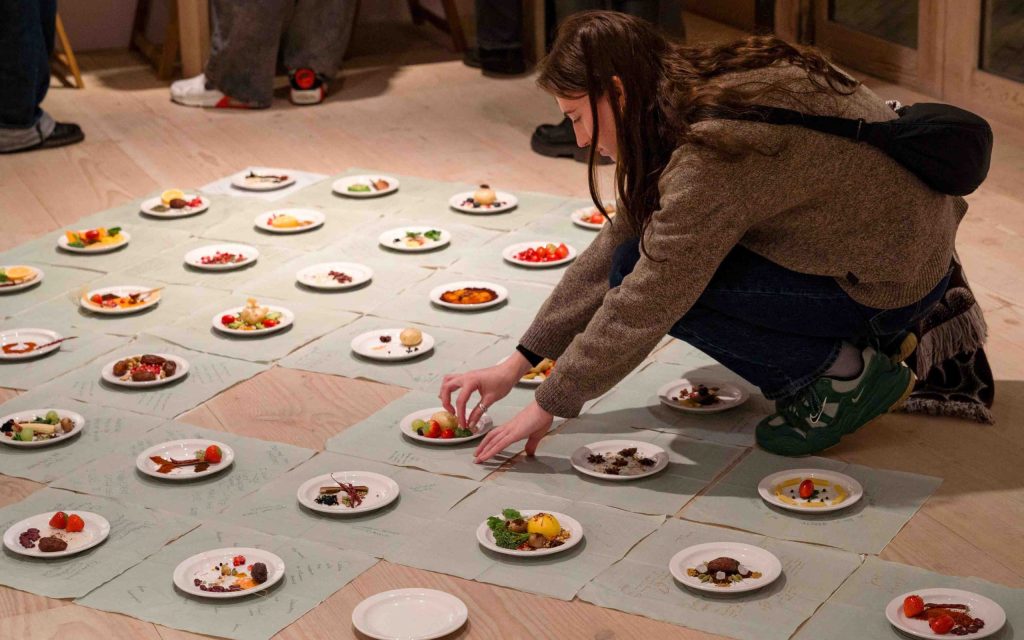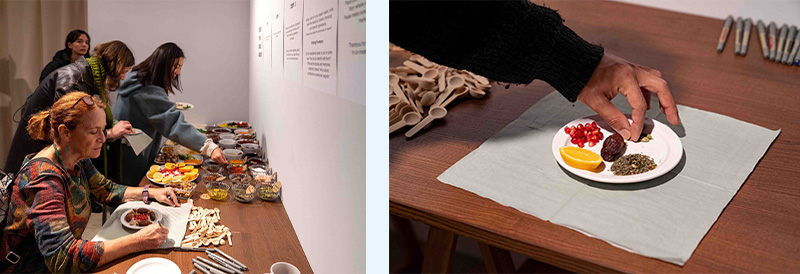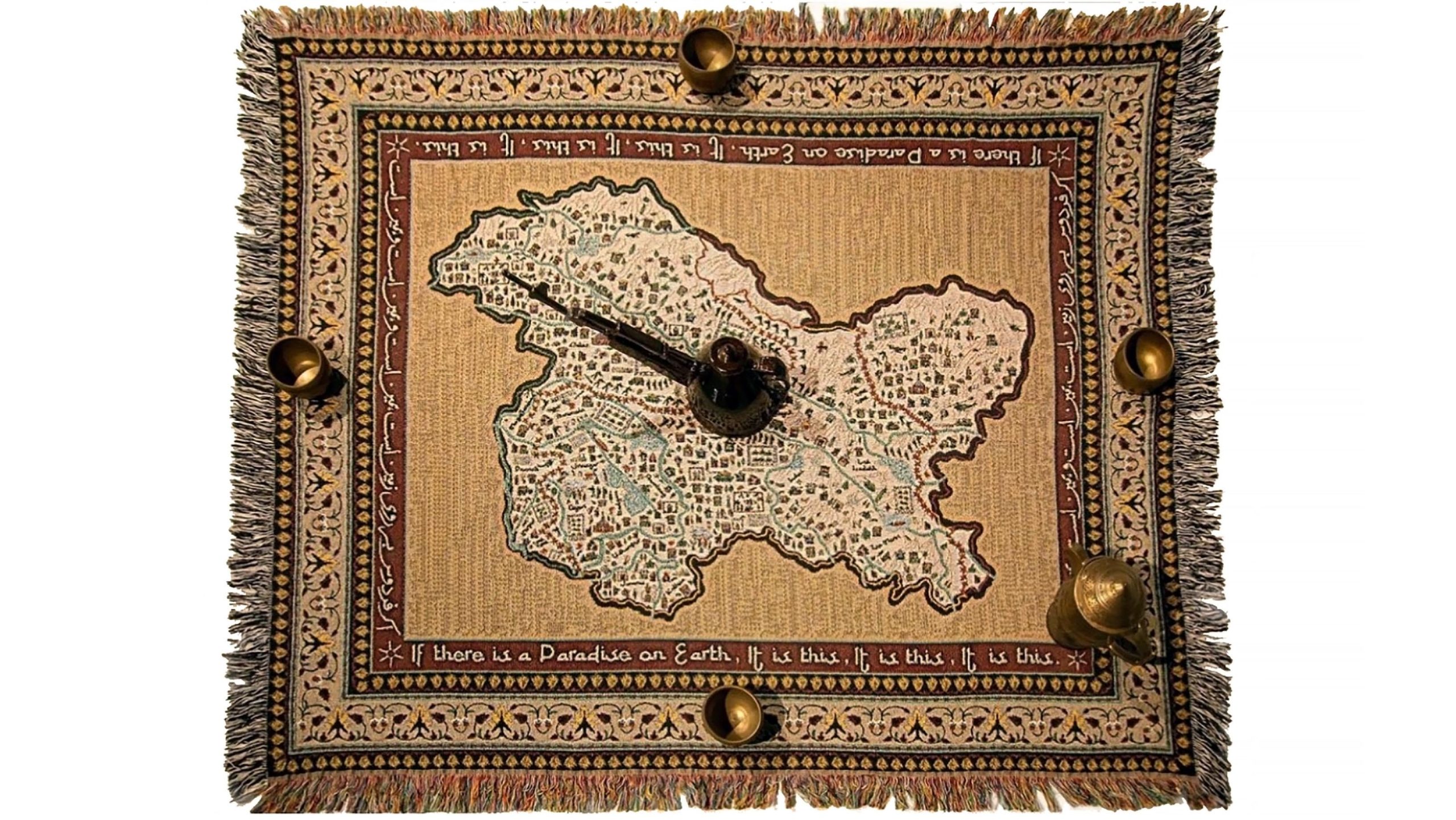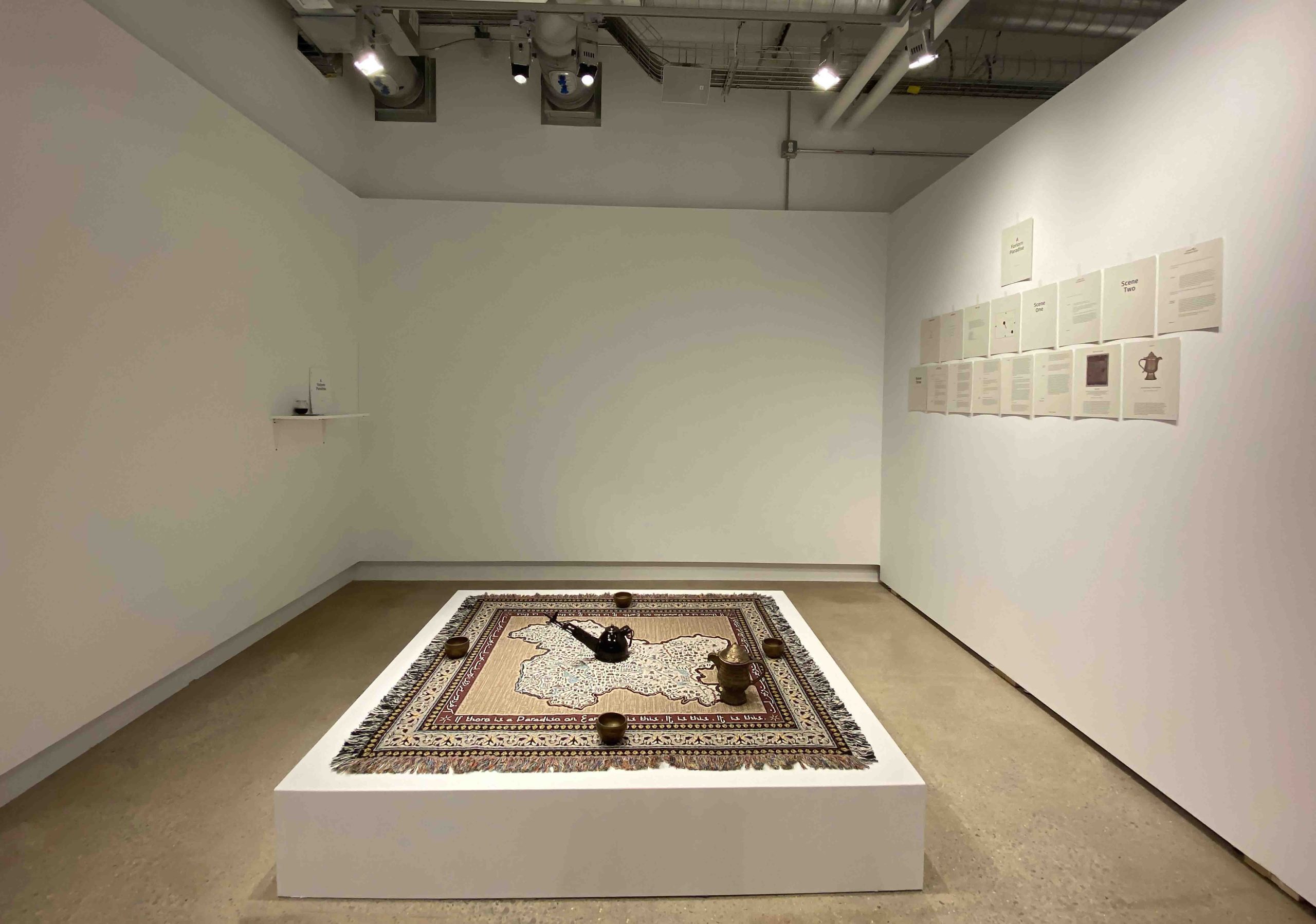
Sidra Khawaja, Edible Archive (2024-ongoing) – Food based participatory art installation during December 2024 Open Studios, Delfina Foundation. Food ingredients, plates, paper napkins, sharpie. Photo: Anne Tetzlaff.
From an open call for artists based in Pakistan, Sidra Khawaja was selected for a residency that took place during our autumn 2024 season, supported by British Council Pakistan in partnership with Foundation Art Divvy. After her residency, we sat down and reflected on her time in London – specifically the projects she developed during that period, and how they continue to evolve.
Delfina Foundation: You were a resident at Delfina during one of our ‘open seasons’, which offers a time to really develop artistic practice and be alongside other residents who are working across a range of materials and themes within their work. What was the experience like in this kind of season where you have a vast array of practices so present?
Sidra Khawaja: My residency at Delfina during the open season was deeply enriching. The cohort brought together artists from diverse global contexts, which was clearly reflected in the range of practices, techniques, and themes we engaged with during formal presentations. What stood out most for me, though, were the informal conversations that unfolded in shared spaces like the kitchen and dining area. These unstructured exchanges often led to unexpected connections—revealing shared concerns and parallel experiences across vastly different geographies. Those moments of mutual recognition and shared humanity were among the most meaningful aspects of the residency for me.
Delfina Foundation: Your work Edible Archive that showed at Delfina’s autumn Open Studios was extremely well received by visitors. I saw so many members of the public collaborating in the co-creations of the work. It was conceived during your residency at Delfina Foundation. Could you share some insights into how you came about developing the work? Were there any moments during your residency that inspired the project?

Sidra: During my time at Delfina, my primary research focus centered on artistic responses to food culture—a subject I’ve long engaged with, particularly using food as metaphor. The residency allowed me to deepen this inquiry, both conceptually and experientially. Delfina’s Politics of Food programme was a valuable entry point, offering exposure to a wide range of projects at the intersection of food, art, and community. I found inspiration not only in these frameworks, but also in the communal rhythms of the residency—especially the shared meals, which fostered safe, non-hierarchical spaces where honest dialogue naturally unfolded. It was remarkable to observe how food consistently dissolved social barriers, even among strangers.
Alongside this, visits to cultural institutions like the Migration Museum and the Museum of the Home, and everyday engagements with street food vendors, further informed my research. These experiences helped shape Edible Archive, an ongoing artistic research project that explores the archival impulse within food culture. Framed as a participatory gastronomic encounter, it functions as both an ethnographic artifact and a space for co-creation—documenting multicultural practices and intangible heritage through collective storytelling and embodied knowledge.

The Open Studios at Delfina played a key role in activating this work, offering rich social engagement and anecdotal material. In 2025, I developed new iterations in Denmark and Lahore—one centered on Danish bread culture through the co-creation of edible dough vessels baked into a shared ‘breadscape’, and the other on the sensory and communal dimensions of Ramadan food rituals in Pakistani context. Building on this research, I also developed and taught an undergraduate elective titled Designing Culture: Food, Craft & Ethnographic Practices at the School of Visual Arts & Design, Beaconhouse National University—further integrating my socially engaged practice into pedagogical frameworks.


Delfina Foundation: Many residents who come to Delfina often use the time to develop research for their work or build relationships. What was it like shifting into ‘creating’ works when you presented a piece for Open Studios?
Sidra: My residency at Delfina was primarily research-driven, with a focus on critically exploring material culture—specifically food practices and craft traditions—as a way to understand the layered and evolving identity of the Kashmiri diaspora in the UK. From the early weeks of the residency, I began engaging with members of the diaspora community, immersing myself in London’s art scene, visiting museums and exhibitions, and exchanging ideas with fellow resident artists. These experiences collectively shaped my research direction.
The work I presented at the Open Studios emerged as a direct offshoot of this ongoing inquiry. Conceived during the final phase of the residency, the piece invited public participation in its making, blurring the line between artwork and research. It functioned simultaneously as a participatory installation and an active method of archiving. In this context, my role shifted from that of a conventional artist to a facilitator and researcher—holding space for others to contribute, respond, and reflect through the process.
Delfina Foundation: Thinking about Edible Archive, I’m also drawn to other collaborative works like Luminous Symphony (2023). You created an immersive installation that allowed viewers to be active participants by touching the work and creating sound. Have you always been drawn to the participatory potential of your practice, or has this been more recent? What was the reception of Luminous Symphony when it was created?

Sidra: Luminous Symphony was a commissioned art pavilion featured in DATUM 2.3—Pakistan’s first exhibition celebrating the intersection of art, design, and architecture. Conceived as an immersive installation, it comprised nearly 300 kinetic modular units that invited active public interaction. The pavilion became one of the most visited and dynamically engaged spaces at the exhibition, drawing a constant flow of enthusiastic participants.
Reflecting on these projects, I recognise how my decade-long teaching experience has shaped my approach to public engagement. Creating participatory spaces—where audiences are not just viewers but co-actors—has become an integral part of my artistic language. In works such as Luminous Symphony and Edible Archive, this ethos materialises as a living environment—part sculpture, part social choreography—where the artwork evolves through collective presence and interaction.
Delfina Foundation: You work across so many different materials, from sewage pipes for Pipe Dream Pavilion (2024) to plastic, to porcelain, to weaving. Can you share a bit about why this exploration of materials is important for your practice?

Sidra: I come from a formal background in design, but approach my work with the sensibility of an artist. This hybrid training has allowed me to work across a wide range of materials and mediums—both digital and tactile—enabling a fluid, interdisciplinary practice. Material exploration is central to my creative process; it not only shapes the form and aesthetic of each project but also informs its conceptual and emotional depth.
I’m particularly drawn to the sensory and experiential qualities of materials—their textures, resonances, and cultural associations—which influence how audiences engage with the work. Often, the materials I choose carry historical, ecological, or ritualistic significance, adding layers of meaning that connect the personal to the political. This multiplicity in material language, I believe, is a strength—allowing my work to contribute to larger conversations around material agency, sustainability, and environmental responsibility.
Delfina Foundation: You’re one of the co-founders of Kashmir Creatives Collective, a Kashmiri-driven independent and intellectual platform focusing on humanising Kashmir through critical engagement and creative projects. How did you start this work, and what has materialised from these collaborations?
Sidra: As creatives who identify as Kashmiris, we felt a deep absence of meaningful representation of Kashmir and its people in broader socio-political and cultural spheres—especially in the art world. This shared concern led to our first collaboration, Longing for Paradise, a short documentary filmed in Kashmir, followed by a second project (currently in post-production) focusing on the material culture and lived realities of the nomadic Bakarwaal community. While working on these projects, we found ourselves drawn to the larger idea of building a supportive network for Kashmiri creatives—one that could foster visibility, solidarity, and cultural affirmation. These conversations and efforts culminated in the launch of Kashmir Creatives Collective in July 2024.

We imagine the Collective as a grassroots platform that brings together artists, designers, filmmakers, writers, performers, and cultural practitioners—both from Kashmir and the diaspora—to share their practices, amplify each other’s voices, and safeguard the cultural integrity and diversity of the region. Rooted in the idea of community care and creative resistance, our aim is to build a space that can nurture, ground, and heal through art and dialogue—particularly in the context of political conflict, erasure, and misrepresentation.
Our work is anchored in the belief that cultural memory and artistic expression are vital tools for resilience. We are currently building an open-access repository that documents artistic and cultural practices from Kashmir, welcoming contributions from individuals with both formal and informal training. Equally important to us is the process of self-reflection—understanding Kashmir not as a monolithic entity but as a layered, evolving space experienced and interpreted differently by each individual.
As stated in our manifesto, we do not endorse a singular political stance or ideology. Instead, we strive to hold a space that allows for multiplicity—accommodating diverse and critical perspectives on Kashmir without judgment. In doing so, we hope to encourage conversations that are empathetic, inclusive, and rooted in mutual respect, even amidst disagreement. Our outreach continues to grow organically through regular internal discussions, Instagram-based artist conversations, and ongoing relationship-building with creatives across borders. While building this community is a slow and sometimes difficult process, it is driven by deep conviction and care. We believe that speaking, listening, and creating—on our own terms—can be powerful acts of reclamation, especially for those from regions like Kashmir that are often overlooked, oversimplified, or silenced.
Delfain Foundation: Much of your work engages with craft and culinary practices, but I also notice the theme of environmentalism in your work, whether it’s through the use of materials or more specifically Half-inch Himalayas (2025), which is a woven tapestry that embodies the fragility and interconnectedness of the Himalayan ecosystem in the face of climate change. Have you consciously made a decision to examine the effects of climate change in your work, and can you possibly elaborate on how it weaves into your practice of bridging social-political and cultural contexts? I’m not sure if there was also a possible connection to environmentalism with Edible Archive at Delfina Foundation, and the environmental and social impact of the food industry?

Sidra: Yes, environmental concerns have become an increasingly intentional part of my practice, although they emerged organically through my ongoing engagement with food and craft. Initially, my work focused on how these practices carry cultural memory, identity, and resilience—especially communities negotiating displacement, like those in and from Kashmir. But over time, I’ve come to see how deeply these cultural practices are also entangled with ecological systems and histories. For instance, Half-inch Himalayas—a woven tapestry—was conceived as both an aesthetic and political reflection on the Himalayan landscape. While it references the fragility of that ecosystem in the face of climate change, it also gestures toward the socio-political pressures that destabilise it: border militarisation, extractive economies, and the erasure of indigenous knowledge. The medium of tapestry itself, slow and labour-intensive, became a counterpoint to these forms of violence—both ecological and ideological.
Likewise, during my residency at Delfina Foundation, food became more than a mnemonic or cultural artefact. It became a lens through which to examine the global food industry’s social and environmental impact—from seed politics and monoculture to colonial grain routes and soil degradation. My interactions with the Kashmiri diaspora in London, along with readings like Politics of Food, deepened my understanding of how deeply climate and cultural survival are linked.
This intersection has now begun to shape not just my art practice but also my pedagogical interests. I’m currently developing a course titled Regenerative Food Systems, which I hope to teach as part of my inquiry. It will explore alternative and decolonial food practices, environmental justice, and how local systems of knowledge—particularly around land and food—can inform regenerative models for the future. For me, this is part of a broader commitment to reimagining how artistic, social, and ecological systems co-exist and inform each other. So yes, environmentalism is not a separate concern—it’s embedded in the very materials, processes, and questions that drive my work. Whether I’m weaving, thinking, or facilitating dialogue, I’m asking how we might reconnect with the land and with each other in ways that are reciprocal, critical, and regenerative.
Delfina Foundation: There’s a tenderness to your work with some of the materials you use, like porcelain or weaving, or the idea that you’re entrusting an audience with your work, like in Edible Archive. However, there’s also a harrowing aspect to your practice, I’m thinking specifically about A Forlorn Paradise (2021), which sets this scene of possible domesticity but then completely reverts that with the inclusion of Military Kettle (2021) in the installation, which was a hybrid teapot and machine gun. You seem to employ this critical approach to objects, symbols, or food. Can you share how it is to navigate this tenderness while simultaneously engaging with devastating symbols of conflict and trauma?


Sidra: My practice is grounded in a feminist tradition of craft and critical inquiry, which I use to question the patriarchal structures that shape our social and cultural realities. When working within contexts of conflict and trauma, I intentionally lean into feelings of dissonance and discomfort—not to provoke for the sake of it, but to open up more nuanced conversations around complex, often oversimplified narratives. I’m particularly interested in examining how power operates through gendered histories and nationalistic discourse, and I approach this through contextual, material, and visual juxtapositions. I find the everyday and the domestic—what is often considered mundane—deeply poetic. These spaces offer opportunities for honest, sensitive engagement that are often overlooked in broader political or academic frameworks.

Interview conducted by Josie Spalla, the Communications Manager at Delfina Foundation.
